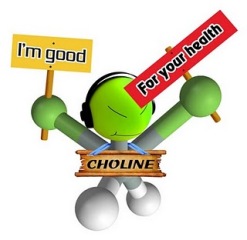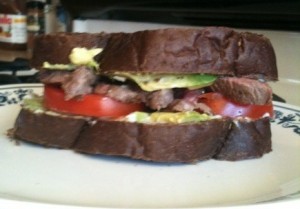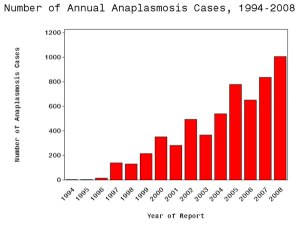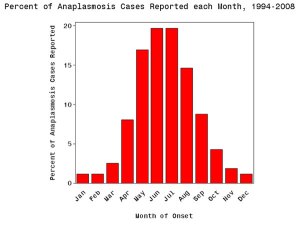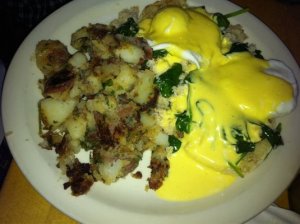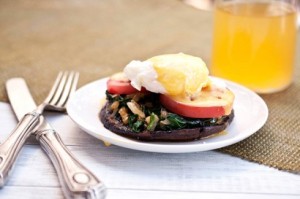The Choline Diet: Herbivore Style 07/01/2012
Posted by thetickthatbitme in Choline Diet, Tick-Lit, Whole Person.Tags: allergy, Anaplasmosis, Borrelia, Borrelia hermsii, choline, diet, health, Lyme Disease, meat, steak, vegetarian
add a comment
In the past, my choline diet posts have been mostly geared towards omnivores, as eating eggs and meat is an easy way to get one’s daily dose of choline. If you’re new to this blog–or just forgetful–I’ve been on a choline-rich diet since I started getting treated for Borrelia hermsii and Anaplasmosis last year. My doctor recommended this because I had some neurological involvement with my illness–brain fog, chronic fatigue, arthralgias–and there’s research that suggests that eating choline helps our bodies produce more of the neurotransmitter acetylcholine. Choline has also been linked to lower levels of inflammation. In addition, choline is particularly important for pregnant women, as higher choline intake during pregnancy is associated with a lower risk of neural tube defects in infants.
So that’s why I’m always telling my readers to eat their eggs and meat and green veggies. However, since a study led by Scott Commins at the University of Virginia linking lone star tick bites to red meat allergies gained national media attention (ABC, CNN) a few weeks ago, I’ve been thinking about how to make my choline recipe recommendations more herbivore-friendly.
After my last choline-related post, I stumbled upon the USDA Database for the Choline Content of Common Foods, which is a fairly good resource (and handy since it comes in a searchable PDF), although it doesn’t include everything I like to eat. (For example, the desserts section is severely lacking.) The other issue with it is that the choline values are reported in mg per 100 grams of food, and the average person may not eat 100 grams of some of those food items in one sitting–particularly the spices. (100 grams of chili powder, anyone?) So keep in mind that the choline numbers below are based on that ratio, and don’t think you’re getting 120 mg of choline in a pinch of mustard seed. This week, I decided to go through the database and find the foods with the most choline. For my herbivore/vegetarian readers out there, whatever your reason for avoiding meat (moral, dietary, tick-bite-induced allergy…), here are the top choline sources from several non-meat categories:
Top 10 Veggies:
- edamame—56 mg*
- broccoli (boiled) —40 mg
- cauliflower (boiled) —39 mg
- tomato paste—39 mg
- artichokes (boiled)—34 mg
- peas (boiled)—28 mg
- spinach (cooked) —28 mg
- asparagus (boiled) —28 mg
- sweet corn (boiled) —22 mg
- red potatoes (baked) —19 mg
Top 10 Fruits:
- dried figs—16 mg
- clementines—14 mg
- avocados—14 mg
- dried apricots—14 mg
- raspberries—12 mg
- raisins—11 mg
- prunes—10 mg
- mandarin oranges—10 mg
- medjool dates—9.9 mg
- bananas—9.8 mg
Top 10 Nuts and Seeds:
- flaxseed—79 mg
- dry roasted pistachios—71 mg
- roasted pumpkin seed kernels—63 mg
- roasted cashews—61 mg
- dried pine nuts—56 mg
- sunflower seed kernels—55 mg
- almonds—52 mg
- hazelnuts—46 mg
- dry roasted macadamia nuts—45 mg
- pecans—41 mg
Top 5 Legumes:
- creamy peanutbutter—66 mg
- boiled navy beans—45 mg
- baked beans—28 mg
- firm tofu—28 mg
- soft tofu—27 mg
Top 10 Spices:
- mustard seed—120 mg
- dried parsley—97 mg
- garlic powder—68 mg
- chili powder—67 mg
- curry powder—64 mg
- dried basil—55 mg
- paprika—52 mg
- ground turmeric—49 mg
- ground ginger—41 mg
- onion powder—39 mg
*All measurements are given in mg/100 g of food
I hope these lists get you on your way to a diet more rich in choline, whether it includes meat or not.
This concludes the herbivore section of this post. If you don’t want to be tempted with any meat, try clicking over to some of my other posts.
***
If you’re here in search of choline diet inspiration of the omnivore variety, I haven’t completely forgotten you. Here’s a glimpse of what I had for lunch.
Happy Sunday, everybody! And watch out for ticks!
Related articles
- Eat Your Eggs, Benedict!
- Snacking in the name of choline
- Ehrlichia: confusing cousins, the blood supply, and the new kid on the block
- My Story
- Four (surprising) places ticks hang out
- Fresh Friday: 10 Reasons to Eat Egg Yolks (doubleeaglefitness.wordpress.com)
Eight things you need to know about Anaplasmosis 04/25/2012
Posted by thetickthatbitme in Diagnosis, TBI Facts.Tags: Anaplasma phagocytophilum, Anaplasmosis, Borrelia burgdorferi, doxycycline, health, labs, Lyme Disease, medicine, Rocky Mountain Spotted Fever, tick, treatment
5 comments
A new fact sheet is up today for Anaplasmosis, otherwise known as Anaplasma phagocytophilum infection. Try saying that three times fast. This is one of the two TBIDs I’ve been unlucky enough to have, but I had never heard of it before my lab results came back with a positive antibody test for it. By the end of this post, you’ll know eight things you didn’t know before about Anaplasmosis.
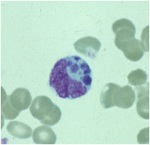
A microcolony of A. phagocytophylum visible in a granulocyte (white blood cell) on a peripheral blood smear. Image via CDC.gov.
1. Anaplasmosis is spread by the same ticks that spread Borrelia burgdorferi (Lyme Disease). This means that people with Lyme can have a coinfection with Anaplasmosis (and some of them don’t know it).
2. The symptoms of an Anaplasma phagocytophilum infection are: fever, headache, muscle pain, malaise, chills, nausea / abdominal pain, cough, and confusion. Some people get all the symptoms; other people only get a few.
3. If you show symptoms of Anaplasmosis, your doctor shouldn’t wait for lab results to come back to begin treating you. The CDC recommends beginning treatment right away.
4. If you’ve been infected with Anaplasma phagocytophilum and you get tested within the first 7-10 days you are sick, the test might come back negative. This doesn’t mean you don’t have Anaplasmosis, and you’ll need to be tested again later.
5. The best way to treat Anaplasmosis is with the antibiotic Doxycycline. According to the CDC, other antibiotics should not be substituted because they increase the risk of fatality. If your doctor insists on treating your Anaplasmosis with something other than Doxycycline, it’s probably time to get a new doctor. For people with severe allergies to Doxycycline or for women who are pregnant, the drug Rifampin can be used to treat Anaplasmosis.
6. Anaplasmosis can be confused with other TBIDs in the rickettsia family like Rocky Mountain Spotted Fever (RMSF) and ehrlichiosis. These infections are also commonly treated with Doxycycline.
7. The number of cases of Anaplasmosis reported to the CDC has increased steadily since 1996. You can attribute this to climate change or not, but the trend suggests that this disease will be an increasingly more common problem in the future.
8. More than half of Anaplasmosis cases are reported in the spring and summer months. This is a no-brainer, since this is when tick populations thrive. To avoid infection, take steps to avoid tick exposure for both you and your pets.
Eat Your Eggs, Benedict! 04/22/2012
Posted by thetickthatbitme in Choline Diet, Whole Person.Tags: Anaplasmosis, benedict, Borrelia burgdorferi, Borrelia hermsii, choline, diet, eggs, HBO, inflammation, Lyme, mushroom, recipe, salmon
5 comments
If you know my story, you know that when I was diagnosed with B. hermsii and Anaplasmosis, my doctor put me on a high-choline diet. Why choline, you ask? Choline is a B vitamin that aids in the transmission of nerve impulses from the brain through the central nervous system–this process is essential to functions like memory and muscle control. Since Borrelia like to attack the central nervous system, choline is especially important for people with (past and present) B. hermsii and B. burgdorferi infections. People who eat diets high in choline have also been shown to have lower levels of inflammation (like inflammation of the joints in Arthritis) than people who don’t. You can read more about choline here.
Enter the Benedict. It is by far my favorite egg-based dish, and I enjoy making it at home just as much as I do eating it for brunch in a fancy restaurant.
One large poached egg has 100 mg of choline, so if you eat two, you get about half of your recommended daily amount (425 mg for women, 550 mg for men). Add to that other high-choline foods like smoked salmon (129 mg), Canadian bacon (39 mg), portabella mushrooms (39 mg), spinach (35 mg), asparagus (23 mg), avocado (21 mg), and tomato (6 mg) to get your choline fix!
Here are my top five Benedicts:
1. Old Fashioned but Fried
for those mornings (or afternoons, or evenings!) when I’m feeling traditional, yet lazy
I learned this simple recipe from my mother, and it
brings back all kinds of fond childhood memories. A toasted whole-wheat English muffin, topped with pan-fried Canadian bacon and over-easy eggs (make sure they’re still a little runny, because that’s the best part). The hollandaise sauce I usually make with one of those sauce packets you can find in the grocery store (next to the gravy packets). It’s easy–you only need to add milk and butter–and, in my opinion, it tastes better than the from-scratch hollandaise recipes I’ve tried. Because of the butter and bacon, this is a slightly fattening meal, so I balance it with a side of boiled asparagus, which tastes delicious with the hollandaise sauce and adds 23 mg of choline to this meal!
Choline count: eggs 200 mg + Canadian bacon 39 mg + asparagus 23 mg = 262 mg of choline
2. Crab Benedict
for when I’m feeling crabby or rooting for the Terps
I’ve never made this one at home, but I’ve had it at Toasties Cafe, and it is delicious!
Choline count: eggs 200 mg
3. Portabello Mushroom Benedict
for the fungus-lovers amongus
If you’re looking for a meatless meal or just craving these yummy mushrooms, this is the Benedict for you. Check out Jackie Dodd’s recipe at TastyKitchen.com, which also includes spinach, tomatoes, and Sriracha for a kick!
Choline count: eggs 200 mg + portabello mushrooms 39 mg + spinach 35 mg = 274 mg of choline
4. Tomato Avocado Benedict
because I’m a California girl
My mouth was watering as I scrolled through SoupBelly.com’s deliciously illustrated recipe for this west-coast Benedict. If you want to make it even more California, use sourdough English muffins.
Choline count: eggs 200 mg + avocado 21 mg + tomato 6 mg = 227 mg of choline
5. Eggs Hemingway
for when I’m feeling literary
This one may seem a bit fishy, but I assure you it’s delicious and packed with choline. It’s also called Norwegian Benedict. Here’s a recipe at food.com that includes not only salmon but spinach, too!
Choline count: eggs 200 mg + smoked salmon 129 mg + spinach 35 mg = 364 mg of choline
Now that I’ve made myself really hungry, I’m going to go make my own Benedict. Hope you enjoy these eggcellent (sorry, I couldn’t resist) high-choline meals!
